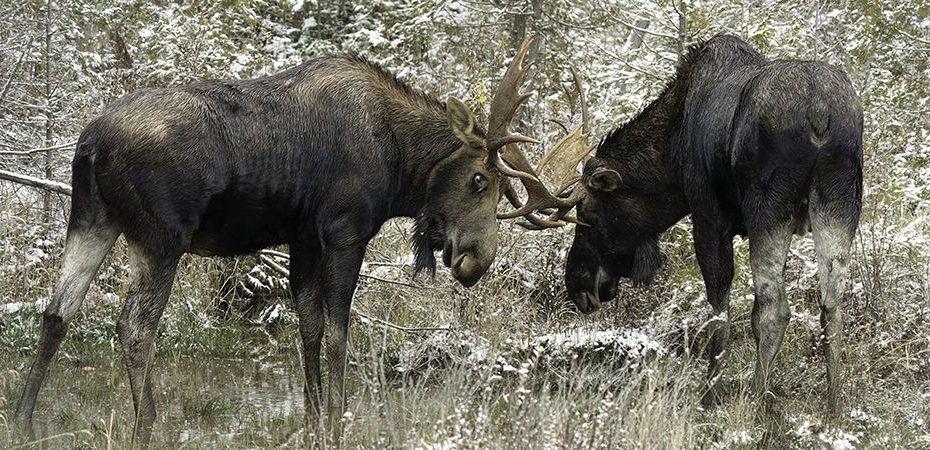There is beauty around every corner of Algonquin Provincial Park. Canada’s first provincial park hosts more than 45 species of mammals, 250 species of birds, and 30 species of reptiles and amphibians. This blog profiles five charismatic species that shape the park and make it such a magical place.
1. Moose
Moose are best seen in the spring as they search for sources of salt and new growth. Perhaps the most exciting is the fall when bull moose spar for breeding rights. Moose remain an important source of food and clothing for many Indigenous Peoples today. Throughout winter moose consume leaves, twigs and the buds of woody plants. This changes in the summer as they crave richer sources of nutrients including aquatic vegetation, grasses, sedges and flowering plants. Given their size, unique behaviour and historical importance, moose top the list.
Moose © Jake Zamora
2. Beaver
The North American beaver is considered a “keystone species” due to its ability to shape the landscape. The construction of dams and lodges have shown to decrease erosion, help with drought protection, decrease floods and increase fish populations. Beavers typically feed on bark, leaves, twigs, buds and aquatic vegetation. Beaver pelts played a vital role in trade and the trading posts that were developed and shaped much of how Canada is navigated today.
North American beaver © Jake Zamora
3. Loon
The common loon is the official bird of Ontario and closely linked to symbols of wilderness and tranquillity. Their bright red eyes allow for sight while diving in search of fish, frogs, leeches, crayfish, insects and other aquatic species. Pairs can be found on most lakes in Algonquin, though in many regions populations are declining due to impact of global warming, boat traffic, degradation of water quality and disruption of shoreline breeding habitat. Their contribution to the sounds of the wild and their representation of a healthy water ecosystem has earned a spot on the list.
Common loon © Jake Zamora
4. Black Bear
American black bears are omnivores and during winter months can lose up to 40% of their weight. They will eat insects, amphibians, fawn and moose calves though predominantly consume plants including berries, fruit, nuts, acorns, grass and leaves. Bears are commonly found in Algonquin Park, though they mostly avoid humans. Bear scat provides valuable nutrients to the forest and thousands of seeds that are not fully digested will spread to other regions increasing the biodiversity of a forest.
Black bear © Jake Zamora
5. Eastern Wolf
The eastern wolf – also known as the Algonquin Wolf – is the most elusive on the list. Most park visitors will never spot a wolf though they may be lucky to hear calls in the night. Howling is a means of communication for territorial expression, hunting, social interaction and rallying. The eastern wolf is a threatened species in Ontario. Its main prey includes beaver, deer and moose. They will also eat rodents, amphibians, reptiles and birds. The biggest threat to wolves is human activities such as habitat degradation and road traffic. Like bears, wolves help to prevent over grazing by keeping prey on the move. Packs will cover a large home range and in a rapidly developing world demonstrates the need to protect larger uninterrupted natural areas.
Algonquin wolf © Jake Zamora
The importance of the moose, beaver, loon, black bear and eastern wolf is what makes the case for the Algonquin Big Five. Please let us know your Big Five for Algonquin in the comments.
Resources
The post Algonquin’s Big 5: Meet the Most Captivating Wildlife appeared first on Ontario Nature.
